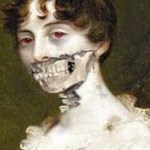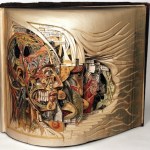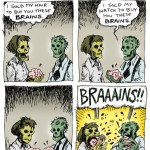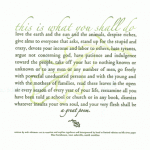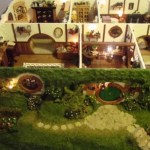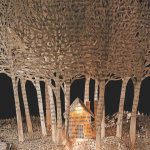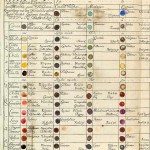Littademia
From Linda Holmes, a poignant post about how the deluge of information makes it impossible to scratch the surface in a single lifetime:
there are really only two responses if you want to feel like you're well-read, or well-versed in music, or whatever the case may be: culling and surrender.
Culling is the choosing you do for yourself. It's the sorting of what's worth your time and what's not worth your time. It's saying, "I deem Keeping Up With The Kardashians a poor use of my time, and therefore, I choose not to watch it." It's saying, "I read the last Jonathan Franzen book and fell asleep…
Wait - did Peter Nowogrodski just shoehorn everything I love into one meandering, indulgent multimedia essay??*
Tolkien's Shire appears as a coherent ecosystem, cradled by productive fields and populated by abundant orchards, caches of edible mushroom, and even the fishable Bywater Pool, ornamented with an authentic churning mill. The land at Hobbiton is changing still: Jackson's crowning oak tree now sits in sun-scarred pieces behind a rotten wooden fence at the termination of Bagshot Row, a home for the welcome swallows that course through air above. In the pastures opposite Bag End, a…
O designer-readers who like to work and play with Photoshop, this contest may be up your alley: Quirk Books, the outfit behind Pride and Prejudice and Zombies, has joined with Bridgeman Art Library to invite submissions for its "Art of the Mash-Up" competition. Basically, they want you to prove you can do better than the Regency unmentionable pictured above:
The iconic "Zombie Lady" on the cover of the New York Times Best Seller Pride and Prejudice and Zombies captured the imagination of readers around the world and has become one of the most recognizable book jackets in recent history.…
Lest any of my faithful readers think they're the only ones whose wonderful linky suggestions I don't seem to get around to posting, my boyfriend sent me this and I didn't post it, and apparently it's on the Daily Dish and 3QD today & he's all like "why didn't you post it sooner? Didn't you get my email??"
Sigh.
So for the record: Brian Dettmer is amazing. He makes these sculptures by carving away - not adding or repositioning - the pages of old illustrated books. And another thing that's really cool: letting the blogosphere (that's me!) disseminate and respond to his work is part of…
A classic tale of love and sacrifice, illustrated by Sean Bieri:
While Bieri's artistry technically depicts a Christmas story, it also nicely captures the undying-even-while-decaying-putrefying-and-hemorrhaging-IQ-points nature of true love. What more could you want for Valentine's Day? (And let's face it, we've all had Valentine's Days that would arguably have been improved by a Zombocalypse.)
Speaking of which, I'm working on my review of Daniel Drezner's Theories of International Politics and Zombies. Short version: it's hilarious.
Gratifyingly, my post on Nabokov and Gould has generated interesting feedback, including this post by Jonah Lehrer, who expands on Nabokov's own opinion of how his science informed his art. (Let's just say he and Gould didn't see eye-to-eye.) The post includes some wonderful Nabokov quotes about science, art, and butterflies, and Lehrer's writing is, as always, lovely:
For Nabokov, the entire universe was just an elaborate puzzle waiting to be figured out. It didn't matter if one was talking about a novel or the evolution of an insect or a chess problem: Nabokov knew that the way to solve the…
Dark pictures, thrones, the stones that pilgrims kiss,
poems that take a thousand years to die
but ape the immortality of this
red label on a little butterfly.
- excerpt from Vladimir Nabokov's "On Discovering a Butterfly"
It's not very well known that novelist Vladimir Nabokov, author of Lolita, was also a lepidopterist; for six years, he was a Research Fellow at the Harvard Museum of Comparative Zoology (now part of the HMNH). Carl Zimmer recounts in the NYT how Harvard professor Naomi Pierce recently set out to test Nabokov's hypotheses about blue butterfly speciation, and discovered…
How often people speak of art and science as though they were two entirely different things, with no interconnection. An artist is emotional, they think, and uses only his intuition; he sees all at once and has no need of reason. A scientist is cold, they think, and uses only his reason; he argues carefully step by step, and needs no imagination. That is all wrong. The true artist is quite rational as well as imaginative and knows what he is doing; if he does not, his art suffers. The true scientist is quite imaginative as well as rational, and sometimes leaps to solutions where reason can…
Here are some essay links I've had open as tabs in my browser for over a week, waiting to be posted. Unfortunately, I don't have time to do the extensive commentary they deserve, so I'm admitting that, and just posting them already. Enjoy.
Graphical Abstracts & Biologists as Designers
Andrew Sun discusses "graphical abstracts" at nature network:
Although they are irrelevant to the quality of the research in my opinion, graphical abstracts (GAs) are in fact increasingly appreciated nowadays. No matter you like them or not, chances are that you have to draw one in order to publish your…
Because people have been discussing Google ngrams a lot, and because there are always major caveats to new datamining methodologies, I have to link Natalie Binder's excellent series of posts urging caution, not only about the methodology, but about assuming too much about ngrams' utility in social research.
Binder says,
The value of the Ngrams Viewer rests on a bold conceit: that the number of times a word is used at certain periods of time has some kind of relationship to the culture of the time. For example, the fact that the word "slavery" peaks around 1860 suggests that people in 1860…
As children sleep, dreaming their materialistic dreams of the privileged classes, Santa - less impressive than his Falstaffian reputation would suggest - twists the narrator's grasp of reality beyond all recognition.
A hilarious tale of Christmas horror by Ryan Iverson, inspired by Warner Herzog. Via iO9.
"This is what you shall do: Love the earth and sun and the animals, despise riches, give alms to every one that asks, stand up for the stupid and crazy, devote your income and labor to others, hate tyrants, argue not concerning God, have patience and indulgence toward the people, take off your hat to nothing known or unknown or to any man or number of men, go freely with powerful uneducated persons and with the young and with the mothers of families, read these leaves in the open air every season of every year of your life, re-examine all you have been told at school or church or in any book…
Today's Guardian has a very interesting (though long) article by Richard Holmes, author of The Age of Wonder, about the unsung women of science. In the Guardian piece, Holmes shares some of his research for his forthcoming book, The Lost Women of Victorian Science:
[M]y re-examination of the Royal Society archives during this 350th birthday year has thrown new and unexpected light on the lost women of science. I have tracked down a series of letters, documents and rare publications that begin to fit together to suggest a very different network of support and understanding between the sexes.…
In less than a month (December 2nd), Christie's will auction off Edward Tufte's library - an idiosyncratic collection of first edition books, plates, prints, and ephemera that the dataviz guru calls his "Museum of Cognitive Art," and I call "Jessica's Christmas List."
I'm not going to sample low-rez images of the lots here, because there's a stunning slideshow, complete with curation, at the Christie's website. If you've got ten minutes, this is virtual antiquarian dataviz windowshopping at its best.
There appear to be 160 lots; Tufte's website describes it as "200 rare books, including major…
My friend Jacob just sent this to me and I had to pass it along.: it's a Bag End dollhouse by Maddie Chambers, apparently one of the most patient people in the world. Amazing and adorable! Can I have a full-sized one please?
In this TED clip, Natalie Merchant sings haunting arrangements of old poetry from her new album, Leave Your Sleep (2CD). If you have limited time, skip ahead to about 8:00 for the beautiful ee cummings poem "maggie and milly and molly and may", followed by the gently rebellious "if no one ever marries me" by Laurence Alma-Tadema (who never did marry), and then "Margaret" by Gerard Manley Hopkins.
I'd forgotten how moving Merchant's voice is. I'll definitely be ordering this one when it's released.
Watch an interview with Natalie Merchant about this project at Granta.
I can't wait to get a copy of Jason Thompson's brand-new project, Playing with Books: The Art of Upcycling, Deconstructing, and Reimagining the Book. Thompson, the founder and creative director of Rag and Bone Bindery, has long kept a blog featuring the best book and paper artists. Now he's edited a book art book, and it looks great. I mean, it has a section on "shaping books with power tools" - what more do you need??
Playing with Books: The Art of Upcycling, Deconstructing, and Reimagining the Book at Amazon
Alan Jacobs finds a quote that beautifully expresses why I don't want a Kindle, and why I wish the iPad were a stylus-friendly Mac tablet:
Of course, you can't take your pen to the screen. When it comes to annotating the written word, nothing yet created for the screen compares to the immediacy and simplicity of a pen on paper. The only effective way to respond to text on screen is to write about it. The keyboard stands in for the pen; but it demands more than a mere underline or asterisk in the margin. It demands that you write.
That, of course, was the reason for the pen all along: it's a…
From Richard Waller, "A Catalogue of Simple and Mixt Colours with a Specimen of Each Colour Prefixt Its Properties"
Philosophical Transactions of the Royal Society of London, vol. 6, 1686/1687 (London, 1688)
Noting the lack of a standard for colors in natural philosophy, and inspired by a similar table published in Stockholm, Richard Waller indicated that his "Table of Physiological Colors Both Mixt and Simple" would permit unambiguous descriptions of the colors of natural bodies. To describe a plant, for example, one could compare it to the chart and use the names found there to identify…
A little Sunday reading: "Mr. Penumbra's Twenty-Four-Hour Book Store," one of several wonderful short stories by San Francisco writer Robin Sloan. It's sort of like magical realism for techies:
Back at Supply and Demand. The air is crackÂling with wi-ââfi; Kat and I are havÂing the only spoÂken conÂverÂsaÂtion in the entire place.She's wearÂing the same red-ââand-ââyellow "BAM!" t-ââshirt as yesÂterÂday, which means a) she slept in it, b) she owns sevÂeral idenÂtiÂcal t-ââshirts, or c) she's a carÂtoon character--all of which are appealÂing alternatives.
I don't want to come out and conÂfess…
